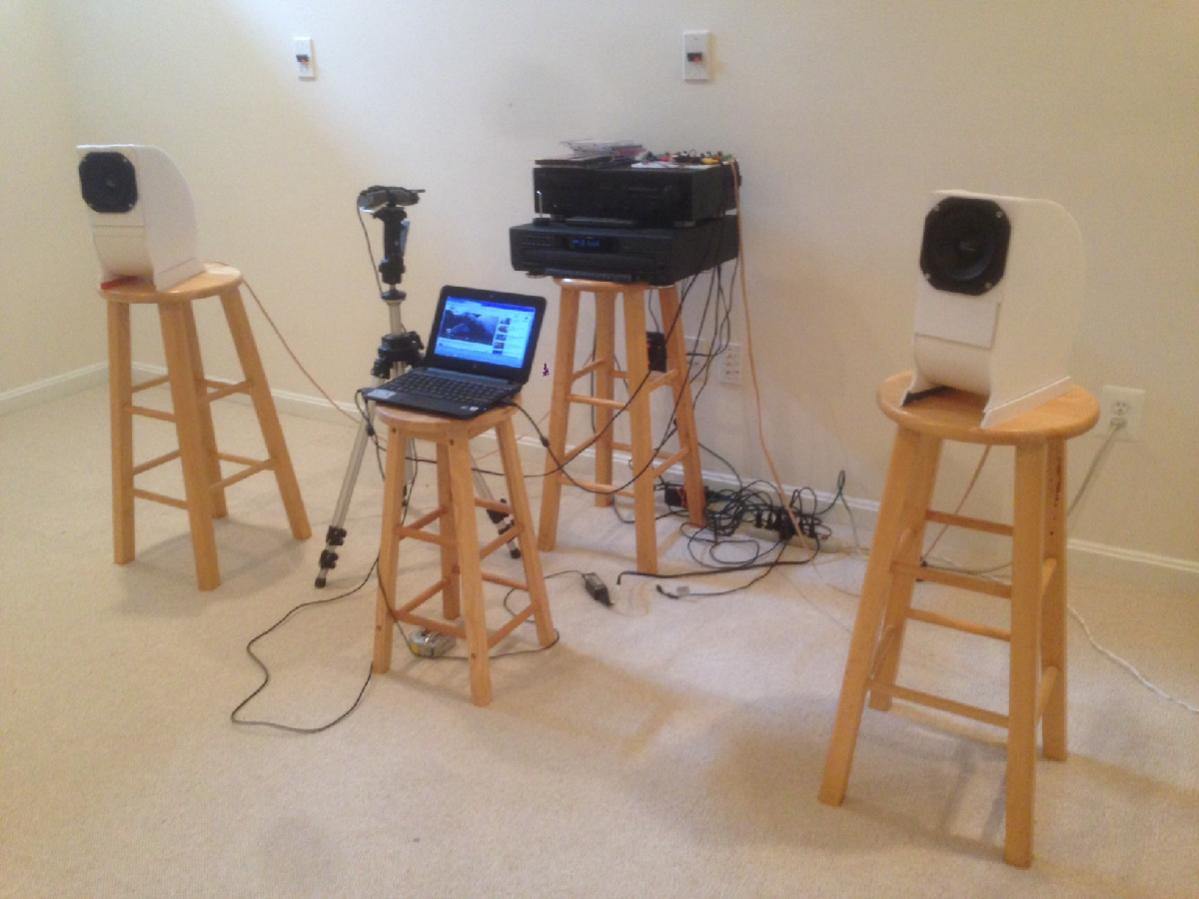Metal is fine as long as it is not very thin - and even if thin, use bracing to prevent large flat areas from vibrating. Will you braze, weld, or use adhesive to hold the spiral to the sides? Sounds very cool. An idea is to make the spiral portion and side panels out of two thin sheets of metal bonded to a thin sheet of rubber or other elastic material. You have a constrained layer damped material that will be very nice as a quiet speaker cabinet.
Mmm, here's something I made back in 2012. Not quite a Nautaloss, but I'll post it here still. More or less the same principle. Pioneer A11 4.5" driver in an Augspurger-style damped TL.
Red: cone output
Green: pipe terminus output
The pipe output would not add to the cone's SPL more than ~1db at 100Hz and 3dB at 50Hz, where output is way down anyway.
An externally hosted image should be here but it was not working when we last tested it.
An externally hosted image should be here but it was not working when we last tested it.
Red: cone output
Green: pipe terminus output
An externally hosted image should be here but it was not working when we last tested it.
The pipe output would not add to the cone's SPL more than ~1db at 100Hz and 3dB at 50Hz, where output is way down anyway.
That looks very nice IG. Is the TL meant to be heavily stuffed to basically attenuate back wave more than to enhance bass? I noticed a dip at 1.5khz - that corresponds to a 6.75 in flat-flat resonance somewhere or is it inherent in the driver? It may be the distance from the top wall to the flat below the driver? I usually put grey eggcrate foam on flat flat faces behind the driver for this reason. Does the cork on the front do anything?
Thanks for posting it.
Thanks for posting it.
That looks very nice IG. Is the TL meant to be heavily stuffed to basically attenuate back wave more than to enhance bass?
I think it's supposed to suppress most output save for a tad of support real low. Mine mostly absorbed it all in the usable BW. Now that I think of it, the final version replaced the fiberglass with polyfill and that last straight segment before the terminus was left un-stuffed, so perhaps there was a tad more output than the above measurement.
I noticed a dip at 1.5khz - that corresponds to a 6.75 in flat-flat resonance somewhere or is it inherent in the driver?
I have other measurements of A11 in various baffles with that dip, I'd say it's the driver. I've never measured anything that extreme even from bare interior walls inches from a driver in any case.
Does the cork on the front do anything?
Very critical. It looks pretty.
To those interested, the Nautaloss can now be simulated in Hornresp since it added simulation of filling/stuffing in horn segments. You can't fully close the pipe terminus, but setting it a 0.01cm^2 is about the same; if it has to tune to any frequency, only whales will hear it.
Last edited:
I'm going to have to get the latest version of Hornresp to play with. The damping and built in filter dialogs are pretty cool. I heard that there is provision for a feedback duct now too. I wish the TS params would be accessible from a separate driver dialog that allows you to pick from a list or database rather than enter each time - and the params are not the conventional Qms, Qes format.
I have had to use the "make the terminus very small" trick to simulate a closed box before too. In AkAbak I have tried opening up the tail off the spiral with a small vent and it really changes the behavior of the speaker both frequency extension wise and impedance plot wise.
I have had to use the "make the terminus very small" trick to simulate a closed box before too. In AkAbak I have tried opening up the tail off the spiral with a small vent and it really changes the behavior of the speaker both frequency extension wise and impedance plot wise.
Last edited:
Hi, I just discovered this thread the other day. I find it to be very interesting and compelling. 
What kind of chamber characters would be needed to build a bass unit with this speaker driver?
Would this be a good choice for a Bass unit?
Goldwood GW-8028 8" Butyl Surround Woofer 8 Ohm
What would the characters of the original Nautaloss be like, if a second driver was placed face-to-face? Two drivers, but one point source?
For my application, my sound source is from my PC DAW.. sound eventually coming from a Behringer ULTRAGAIN PRO-8 DIGITAL ADA8000 and I'm thinking of making two regular Nautaloss and a bass unit. That would take up three channels on the ADA8000, each driven with a TPA3116D2 amp.
And doubling up face-to-face drivers if that would be beneficial?
thank you.
What kind of chamber characters would be needed to build a bass unit with this speaker driver?
Would this be a good choice for a Bass unit?
Goldwood GW-8028 8" Butyl Surround Woofer 8 Ohm
What would the characters of the original Nautaloss be like, if a second driver was placed face-to-face? Two drivers, but one point source?
For my application, my sound source is from my PC DAW.. sound eventually coming from a Behringer ULTRAGAIN PRO-8 DIGITAL ADA8000 and I'm thinking of making two regular Nautaloss and a bass unit. That would take up three channels on the ADA8000, each driven with a TPA3116D2 amp.
And doubling up face-to-face drivers if that would be beneficial?
thank you.
Somewhere in the earlier post on the sub build I did exactly that - doubled the drivers face to face. That is called isobaric driver arrangement and it allows you to cut chamber volume in half and keep same bass extension. You lose efficiency though but in my case the drivers were cheap $5 units and doubling them up stiffened the suspension and there was less ringing in the measured impulse. Pick the Nautaloss chamber volume equivalent to what you would do for a sealed alignment. A high Qts is beneficial for a low fb without EQ and without lots of xmAx.
Came across this speaker and couldn't help thinking of this thread:

https://www.youtube.com/watch?v=kBBltPuw3vs

https://www.youtube.com/watch?v=kBBltPuw3vs
It depends on what the TL was designed to do. If it was designed to extract good bass extension it can be quite effective if lightly to unstuffed with an open vent. If it was designed to act as an infinite baffle and be sealed it will be shorter and tapered with stuffing all the way. Putting an open vent at the end of the Nautaloss does provide more bass extension but then you don't have a single impedance peak anymore and the speaker is now different as it is reactive at multiple tuning frequencies and the cone excursion is different.
Putting an open vent at the end of the Nautaloss does provide more bass extension but then you don't have a single impedance peak anymore and the speaker is now different as it is reactive at multiple tuning frequencies and the cone excursion is different.
That just means it could use some more length/stuffing.
Nautaloss on Steroids
Looks like an overgrown TC9FD with rounded square frame and black paper cone and dustcap.
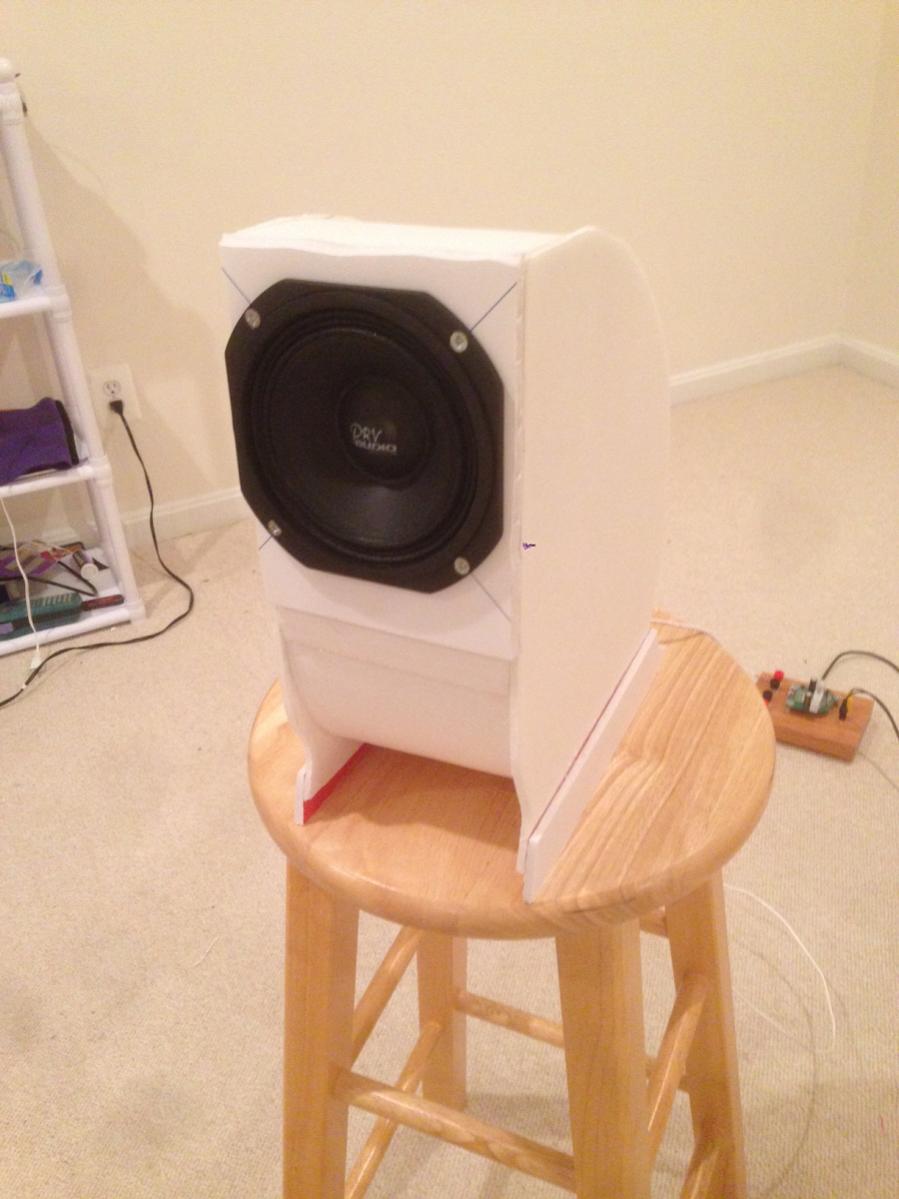
95dB sensitive 5in driver in Nautaloss as test. The PRV 5MR450-NDY (http://www.parts-express.com/pedocs/specs/294-2705s.pdf) is very low distortion driver.
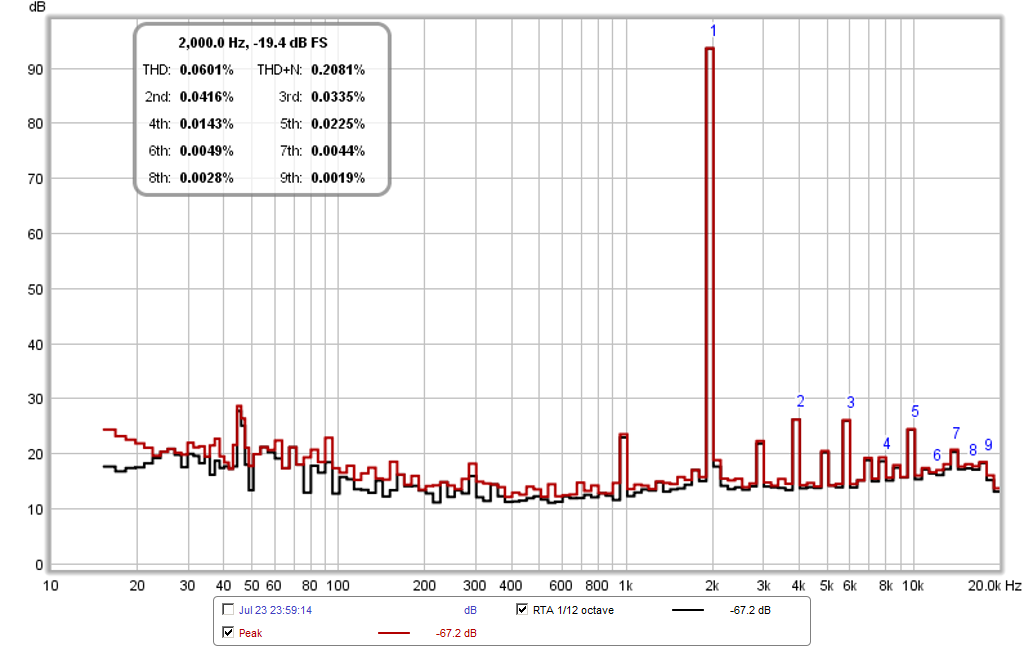
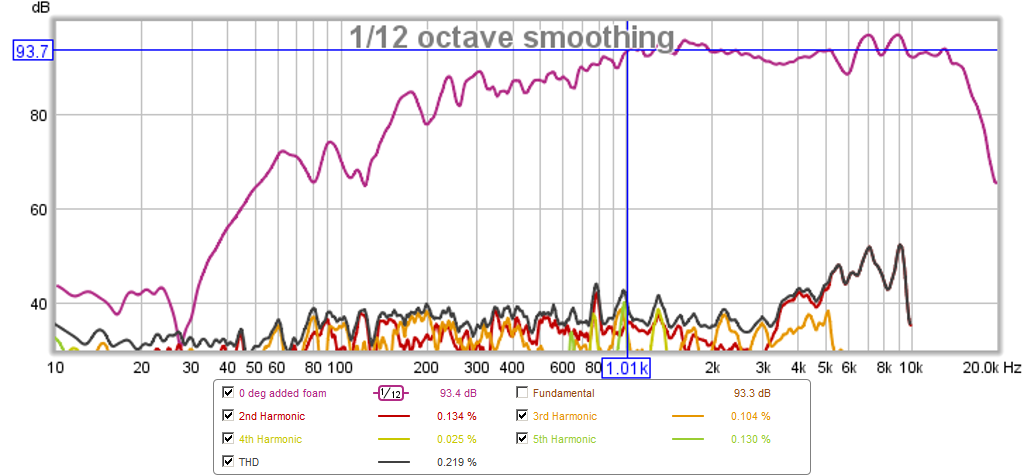
Nautaloss vs 22 in wide OB:
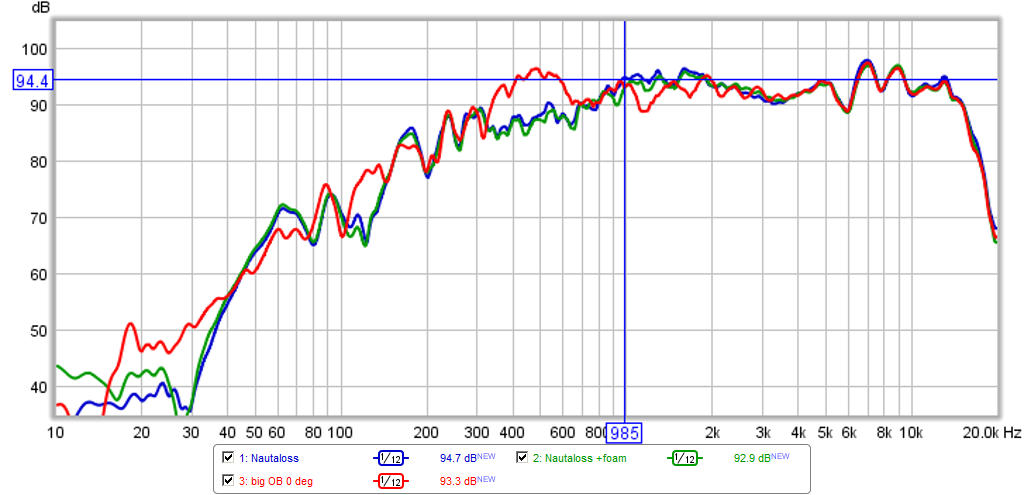
More info here: http://www.diyaudio.com/forums/full-range/259293-prv-5mr450-ndy-fast-applications-3.html#post4001219
Sound clips in mono:
http://www.diyaudio.com/forums/attachments/full-range/430034d1406338686-prv-5mr450-ndy-fast-applications-5mr450ndy-nautaloss-clip-01.zip
http://www.diyaudio.com/forums/attachments/full-range/430035d1406338686-prv-5mr450-ndy-fast-applications-5mr450ndy-nautaloss-clip-02.zip
http://www.diyaudio.com/forums/attachments/full-range/430036d1406338686-prv-5mr450-ndy-fast-applications-5mr450ndy-nautaloss-clip-03.zip
Looks like an overgrown TC9FD with rounded square frame and black paper cone and dustcap.

95dB sensitive 5in driver in Nautaloss as test. The PRV 5MR450-NDY (http://www.parts-express.com/pedocs/specs/294-2705s.pdf) is very low distortion driver.


Nautaloss vs 22 in wide OB:

More info here: http://www.diyaudio.com/forums/full-range/259293-prv-5mr450-ndy-fast-applications-3.html#post4001219
Sound clips in mono:
http://www.diyaudio.com/forums/attachments/full-range/430034d1406338686-prv-5mr450-ndy-fast-applications-5mr450ndy-nautaloss-clip-01.zip
http://www.diyaudio.com/forums/attachments/full-range/430035d1406338686-prv-5mr450-ndy-fast-applications-5mr450ndy-nautaloss-clip-02.zip
http://www.diyaudio.com/forums/attachments/full-range/430036d1406338686-prv-5mr450-ndy-fast-applications-5mr450ndy-nautaloss-clip-03.zip
Last edited:
Here's a set I made using a PRV driver and stacking together many layers of MDF to get the spiral:
Wow! That looks beautiful! Really a fantastic job and I like how you made a bridge to put it above the woofer. Note that putting a driver on the end of a cylinder is perhaps the least ideal way to mount a driver due to baffle step loss and diffraction. However, if you are only using for bass below 300 Hz or so and you have another driver on the rear side in push push bipole then no baffle step loss. In any case, well done!
How do you like the sound of the PRV ? Can you provide some measurments?
Thanks,
X
I'm going to post another thread where I ask how to "fix" the frequency response of this speaker.
I am using these in a desktop setup, wedged against the back wall and against two LCD monitors, so not the best setup. But they do sound better than what I had there earlier - PSB Imagine Mini.
At some point, I will put these up against my Martin Logans.
Yes, the little woofer only plays 250 or 200Hz or lower, so I just tried to make it as compact and "stiff" as possible.
You are right that these speakers play loud very well. OMG
I am using these in a desktop setup, wedged against the back wall and against two LCD monitors, so not the best setup. But they do sound better than what I had there earlier - PSB Imagine Mini.
At some point, I will put these up against my Martin Logans.
Yes, the little woofer only plays 250 or 200Hz or lower, so I just tried to make it as compact and "stiff" as possible.
You are right that these speakers play loud very well. OMG
Here's a set I made using a PRV driver and stacking together many layers of MDF to get the spiral:
Beanbag,
Anymore luck on getting the response of the PRV Nautaloss to flatten out?
Thanks for asking.
I have been trying out a few things these last few days, and will probably post more details in that other thread.
The short version is that I put it in an open baffle, and it still has a little bit of a dip around 1.6kHz. Then I actually stuck the mic against the back side of the driver and measured again. I also saw a big dip in response there, so I think it must be some property of the driver.
I saw the same response in my Martin Logan's woofer, namely a peak, then dip, and then a lower response after that. So must be something intrinsic to cone drivers?
Putting the driver in the box just exacerbates this, and again, I did a measurement where I stuck the mic inside the box, near the driver, and it turns out there is a second dip near this frequency too. I guess I must have designed the angles of the walls to take the back wave and reflect it back into the cone, LOL.
So far, the best result was to stuff near the driver very aggressively, like I showed in one of my plots. Right now, I am gonna try adding a little cone or cylinder to the back of the driver to try and redirect the wave, and also make some little wedges to fill out the two rounded corners above and below the driver.
I tried many other things, and none of them made much of a difference.
Oh, and after this, I will need to "fix" all those high frequency peaks, which are a real mess. Makes me want to just cross over to a tweeter or something...
I have been trying out a few things these last few days, and will probably post more details in that other thread.
The short version is that I put it in an open baffle, and it still has a little bit of a dip around 1.6kHz. Then I actually stuck the mic against the back side of the driver and measured again. I also saw a big dip in response there, so I think it must be some property of the driver.
I saw the same response in my Martin Logan's woofer, namely a peak, then dip, and then a lower response after that. So must be something intrinsic to cone drivers?
Putting the driver in the box just exacerbates this, and again, I did a measurement where I stuck the mic inside the box, near the driver, and it turns out there is a second dip near this frequency too. I guess I must have designed the angles of the walls to take the back wave and reflect it back into the cone, LOL.
So far, the best result was to stuff near the driver very aggressively, like I showed in one of my plots. Right now, I am gonna try adding a little cone or cylinder to the back of the driver to try and redirect the wave, and also make some little wedges to fill out the two rounded corners above and below the driver.
I tried many other things, and none of them made much of a difference.
Oh, and after this, I will need to "fix" all those high frequency peaks, which are a real mess. Makes me want to just cross over to a tweeter or something...
Thanks for asking.
I have been trying out a few things these last few days, and will probably post more details in that other thread.
The short version is that I put it in an open baffle, and it still has a little bit of a dip around 1.6kHz. Then I actually stuck the mic against the back side of the driver and measured again. I also saw a big dip in response there, so I think it must be some property of the driver.
I saw the same response in my Martin Logan's woofer, namely a peak, then dip, and then a lower response after that. So must be something intrinsic to cone drivers?
Putting the driver in the box just exacerbates this, and again, I did a measurement where I stuck the mic inside the box, near the driver, and it turns out there is a second dip near this frequency too. I guess I must have designed the angles of the walls to take the back wave and reflect it back into the cone, LOL.
So far, the best result was to stuff near the driver very aggressively, like I showed in one of my plots. Right now, I am gonna try adding a little cone or cylinder to the back of the driver to try and redirect the wave, and also make some little wedges to fill out the two rounded corners above and below the driver.
I tried many other things, and none of them made much of a difference.
Oh, and after this, I will need to "fix" all those high frequency peaks, which are a real mess. Makes me want to just cross over to a tweeter or something...
Sorry to hear you have not been able to resolve that problem. It may be a bad driver(s). Check the basket frame for small hairline cracks. I had to swap one out for an exchange with PE via RMA because of a crack. I noticed it upon shipment and never bothered to even measure it. If you are happy with the response I posted above (including high freq peaks?) also shown below again, it should be achievable if the drivers are not defective. Even without a visible crack I would exchange them and cite that the measured response has a dip at that is not supposed to be there. PE is pretty good with returns.
Given that you have exhausted all possibilities I would exchange them for new ones. Hopefully the replacements fare better.

- Home
- Loudspeakers
- Full Range
- The Nautaloss Ref Monitor
